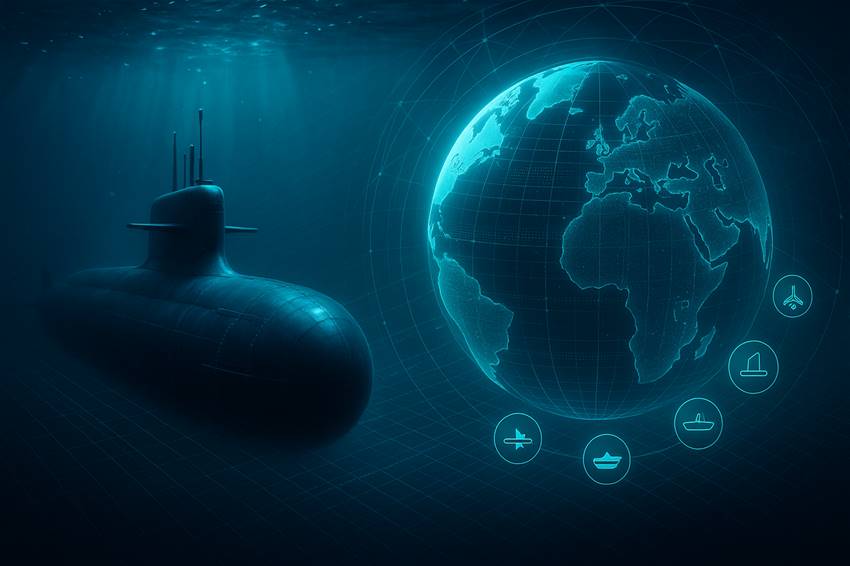
Over the past few years, the ocean floor has once again become the stage for intense strategic competition. The sabotage of telecommunications cables in the Baltic, “gray zone” operations in the South China Sea, and the deployment of naval drones in the Black Sea show that the underwater realm is now as hotly contested as the air space or cyberspace domains. In this unstable context, nations must protect critical infrastructure, safeguard freedom of navigation, and deter acts of sabotage that are hard to attribute. Modeling & Simulation (M&S) is the key tool for anticipating threats, optimizing resources, and making informed decisions, because it enables a range of strategic and tactical operations that deliver concrete advantages:
Cost and risk reduction: Simulating the hydrodynamics of an AUV or acoustic propagation in anti-submarine warfare (ASW) scenarios lets forces validate tactics and sensors before going to sea, cutting ship hours and keeping budgets under control.
Digital twins for predictive maintenance: Digital twins aligned with verification and validation standards predict platform failures, boosting readiness.
Real time decision making: Federating maritime models with data from land, air, and space assets produces a coherent operational picture that speeds up the OODA cycle (Observe–Orient–Decide–Act).
Immersive training: Virtual and augmented reality linked to high fidelity scenarios train multinational crews in complete safety, reducing the risks of live exercises and improving interoperability.
Practical uses of modeling and simulation include:
Protecting submarine cables: Simulations that integrate ROVs, USVs, and sonar sensors to optimize patrol patterns and detect intrusions quickly.
Countering “kamikaze” drones and naval swarms: Virtual wargames that test the effectiveness of counter measures (lasers, UUV hunters, acoustic jammers) before a real-world confrontation.
Gray zone operations in the South China Sea: Multi domain scenarios that combine surface ships, AUVs, and satellites to ensure freedom of navigation and compliance with international law.
Evolving quiet diesel electric fleets: Advanced acoustic detection models supported by AI algorithms to retain the edge in locating and engaging underwater targets.
For more than twenty years GMSpazio has served as a system integrator able to manage the full operational spectrum—undersea, land, air, and space.
Thanks to our distributed architecture based on DIS/HLA standards and Open Mission Systems (OMS) we can link, in a single digital battlespace, large numbers of entities—ships, aircraft, ground units, and space assets—enabling:
Scaling from the tactical to the operational strategic level without recreating models: sensor digital twins remain intact but are federated in multi day campaigns that include logistics, refueling, and command and control chains.
Live Virtual Constructive (LVC) exercises, where real crews use bridge or cockpit simulators connected to constructive forces generated on HPC cloud infrastructure, cutting real flight/sailing hours by 60 %.
Joint force integration: an F 35 in flight, a FREMM frigate, and an air defense platoon can share the same simulated tactical picture in real time, validating Joint Fires doctrine.
Connectivity to NATO networks such as Federated Mission Networking (FMN) for coalition wargames, ensuring compatibility with partners and allies.
Strategic effectiveness analysis: KPIs such as mission package availability, fuel consumption, or logistics corridor saturation are tracked on dashboards, giving decision makers a cost effectiveness balance before authorizing real deployments.
Our article “The Role of Modeling & Simulation in Maritime Defense” (published 14 February 2025) details success stories in ASW, the protection of offshore infrastructure, and the use of autonomous drones for ISR tasks, confirming the centrality of our Sea Land Air Space suite.
The seabed is now an integral part of contemporary hybrid conflict. Only the extensive use of Modeling & Simulation, supported by certified digital twins and true multi domain integration, allows nations to anticipate threats, optimize resources, and deter adversaries. GMSpazio provides the expertise, tools, and proven experience to guide governments and industry through this paradigm shift, ensuring every decision—underwater, on the surface, or in space—is based on solid data and rigorously tested scenarios.





.png)